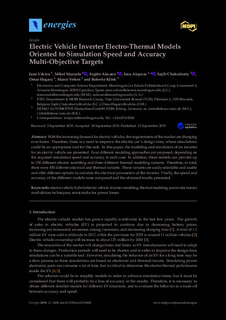| dc.rights.license | Attribution 4.0 International | * |
| dc.contributor.author | Urkizu, June | |
| dc.contributor.author | Mazuela, Mikel | |
| dc.contributor.author | Alacano, Argiñe | |
| dc.contributor.author | Aizpuru, Iosu | |
| dc.contributor.other | Chakraborty, Sajib | |
| dc.contributor.other | Hegazy, Omar | |
| dc.contributor.other | Vetten, Marco | |
| dc.contributor.other | Klink, Roberto | |
| dc.date.accessioned | 2020-06-12T10:56:31Z | |
| dc.date.available | 2020-06-12T10:56:31Z | |
| dc.date.issued | 2019 | |
| dc.identifier.issn | 1996-1073 | en |
| dc.identifier.other | https://katalogoa.mondragon.edu/janium-bin/janium_login_opac.pl?find&ficha_no=153187 | en |
| dc.identifier.uri | https://hdl.handle.net/20.500.11984/1688 | |
| dc.description.abstract | With the increasing demand for electric vehicles, the requirements of the market are changing ever faster. Therefore, there is a need to improve the electric car’s design time, where simulations could be an appropriate tool for this task. In this paper, the modeling and simulation of an inverter for an electric vehicle are presented. Four different modeling approaches are proposed, depending on the required simulation speed and accuracy in each case. In addition, these models can provide up to 150 different electric modeling and three different thermal modeling variants. Therefore, in total, there were 450 different electrical and thermal variants. These variants are easily selectable and usable and offer different options to calculate the electrical parameters of the inverter. Finally, the speed and accuracy of the different models were compared and the obtained results presented. | en |
| dc.description.sponsorship | Unión Europea | es |
| dc.language.iso | eng | en |
| dc.publisher | MDPI AG | en |
| dc.rights | © 2019 by the authors. Licensee MDPI, Basel, Switzerland | en |
| dc.rights.uri | http://creativecommons.org/licenses/by/4.0/ | * |
| dc.subject | electric vehicle | en |
| dc.subject | hybrid electric vehicle | en |
| dc.subject | inverter modeling | en |
| dc.subject | thermal modeling | en |
| dc.subject | power electronics | en |
| dc.subject | modulation techniques | en |
| dc.subject | semiconductor power losses | en |
| dc.title | Electric Vehicle Inverter Electro-Thermal Models Oriented to Simulation Speed and Accuracy Multi-Objective Targets | en |
| dc.type | http://purl.org/coar/resource_type/c_6501 | |
| dcterms.accessRights | http://purl.org/coar/access_right/c_abf2 | en |
| dcterms.source | Energies | en |
| local.contributor.group | Sistemas electrónicos de potencia aplicados al control de la energía eléctrica | es |
| local.description.peerreviewed | true | en |
| local.identifier.doi | https://doi.org/10.3390/en12193608 | en |
| local.relation.projectID | info:eu-repo/grantAgreement/EC/H2020/769935/EU/High Fidelity Electric Modelling and Testing/HIFI-ELEMENTS | en |
| local.rights.publicationfee | APC | en |
| local.rights.publicationfeeamount | 1677 EUR | en |
| local.contributor.otherinstitution | https://ror.org/006e5kg04 | es |
| local.contributor.otherinstitution | https://ror.org/05xtrfa17 | es |
| local.source.details | Vol. 12. Nº 19. 3608, | eu_ES |
| oaire.format.mimetype | application/pdf | |
| oaire.file | $DSPACE\assetstore | |
| oaire.resourceType | http://purl.org/coar/resource_type/c_6501 | en |
| oaire.version | http://purl.org/coar/version/c_970fb48d4fbd8a85 | en |








